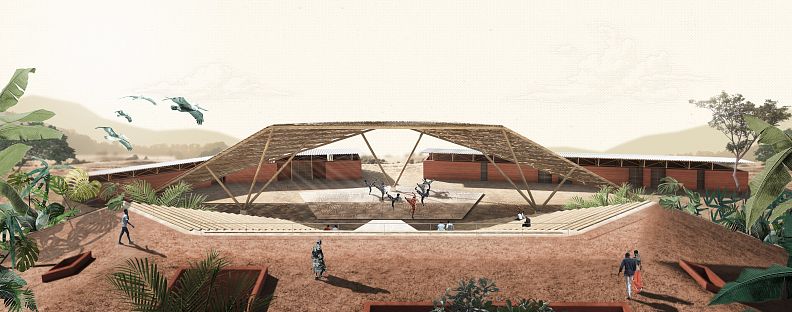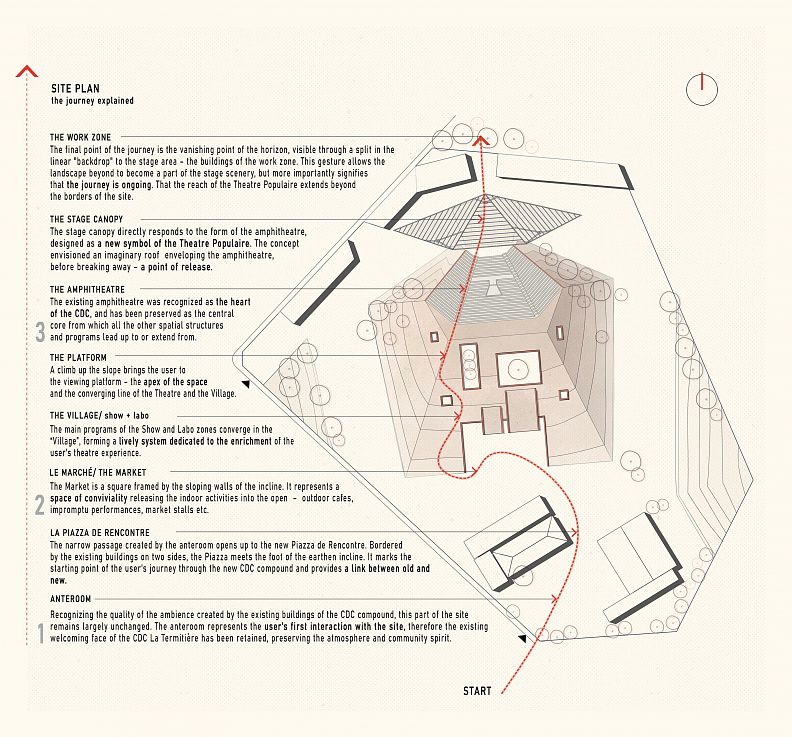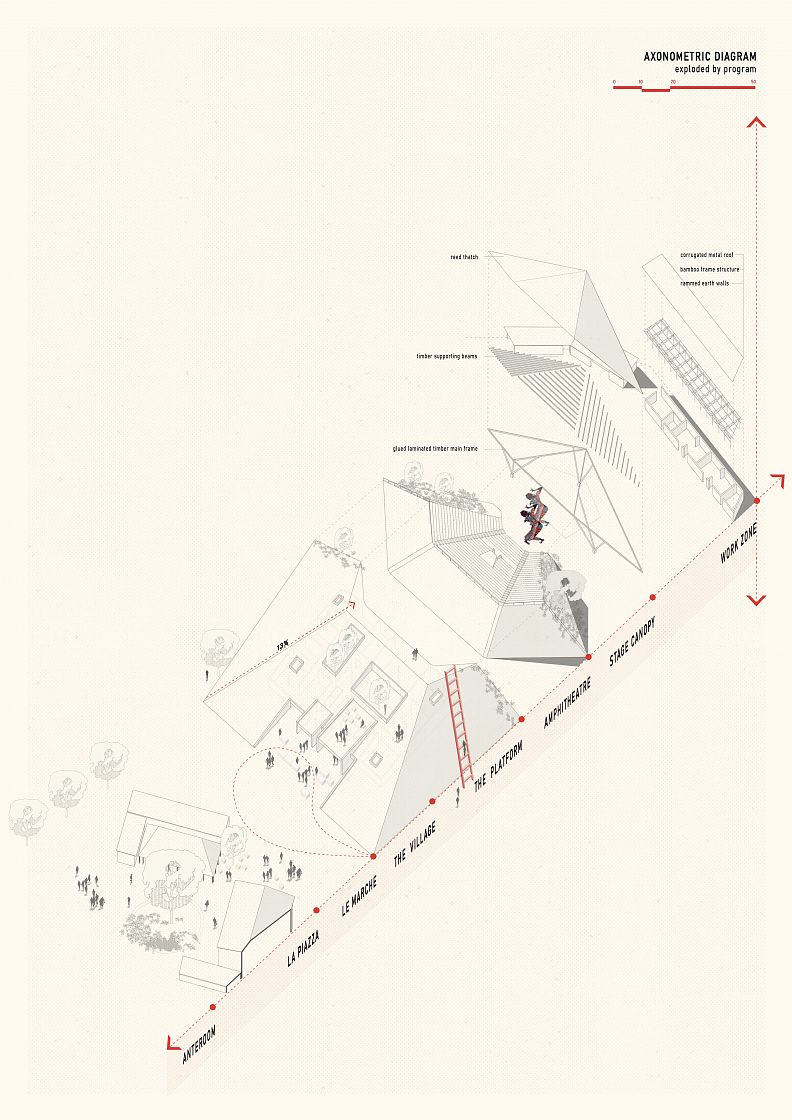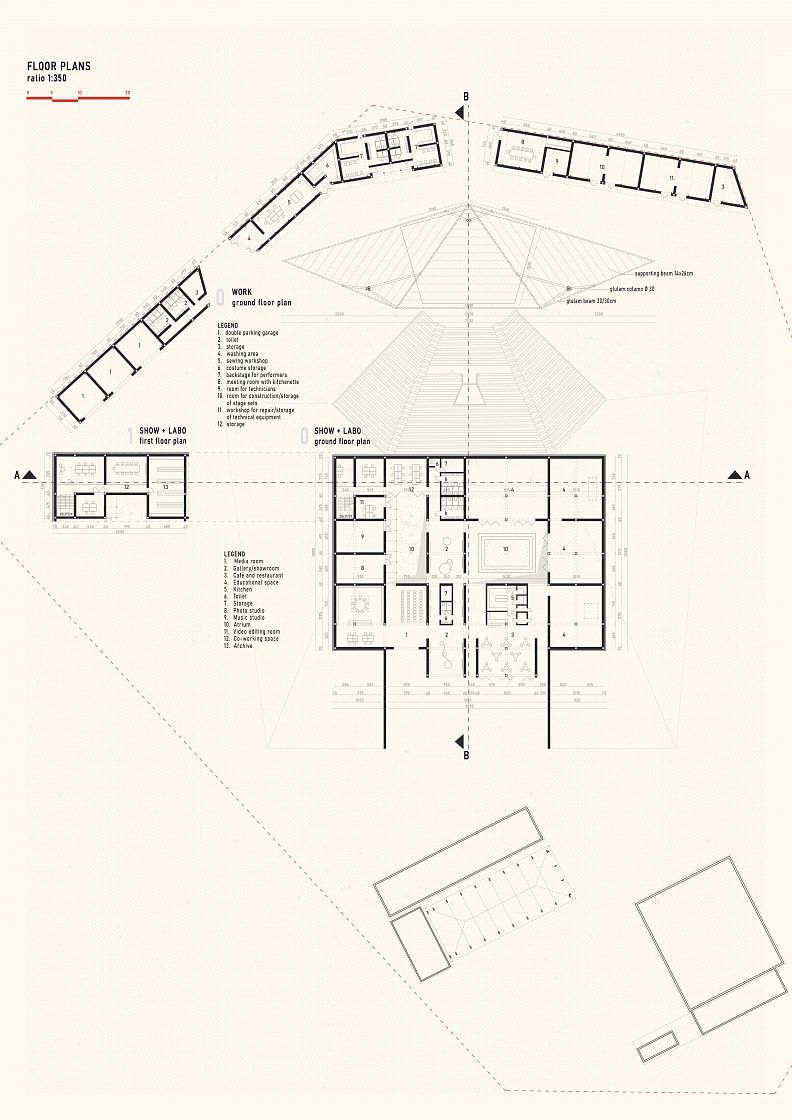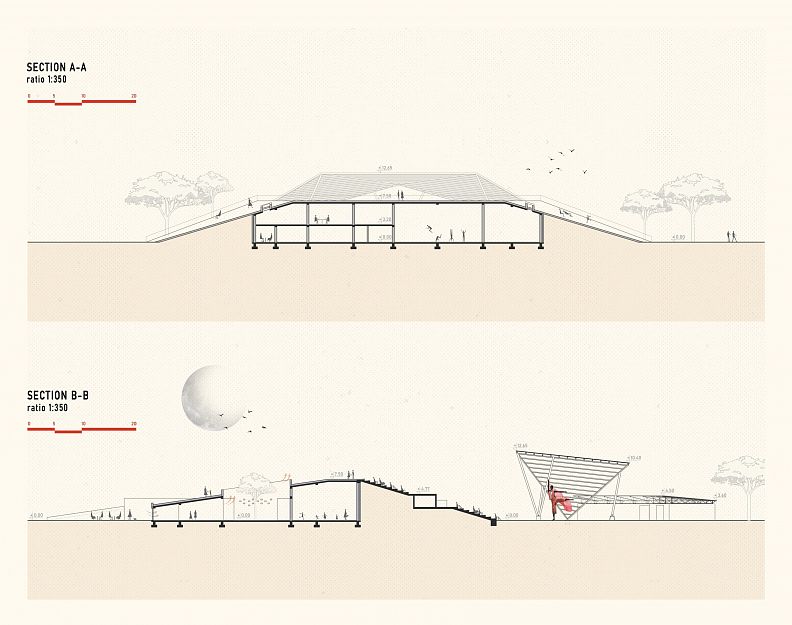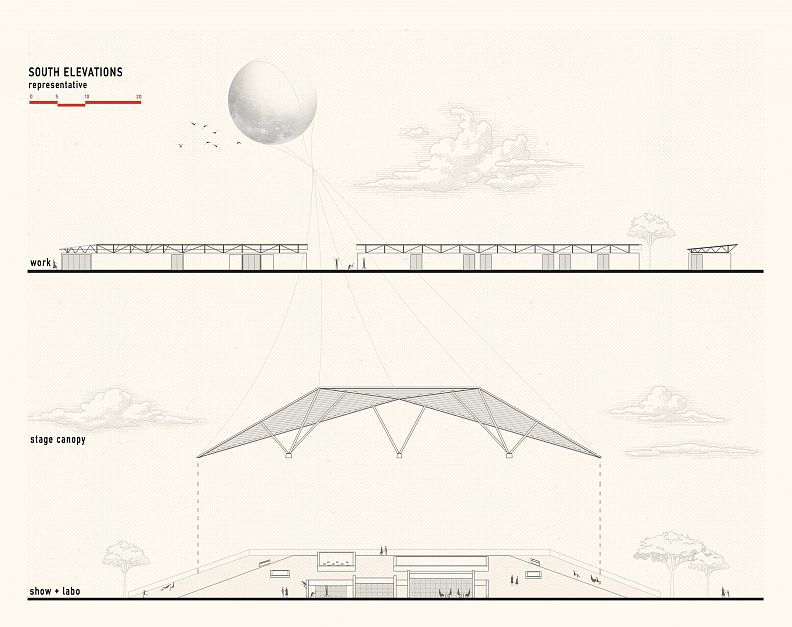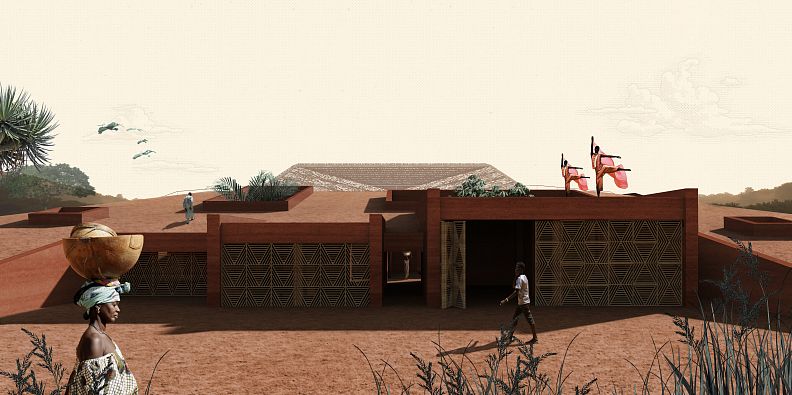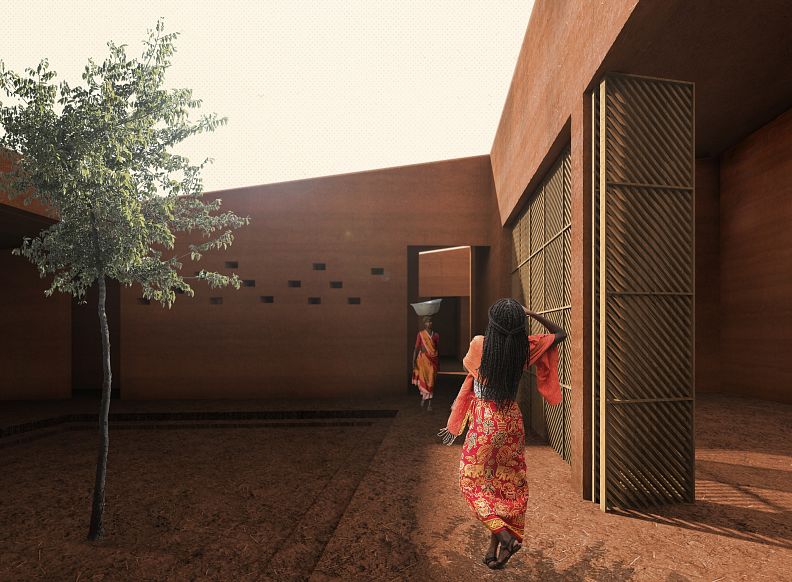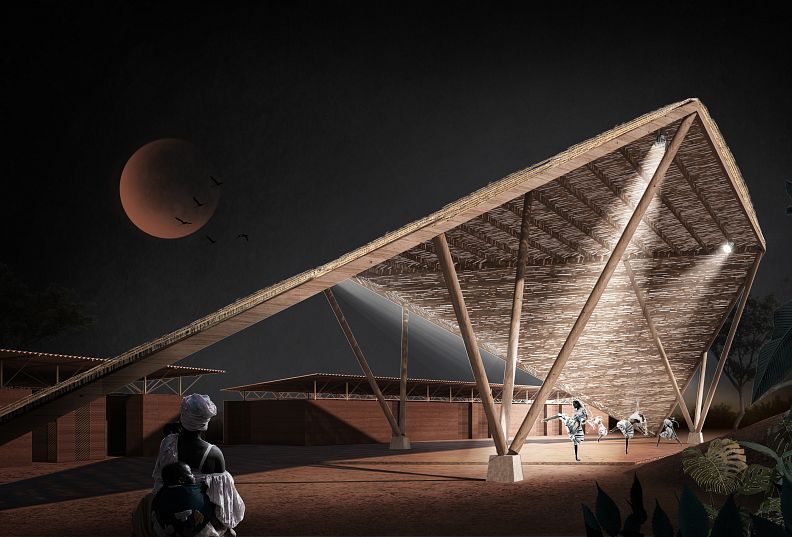Under Earth - Under Canopy

Project idea
"If a termite mound lives, it is because it adds earth to the earth". - Titinga Frédéric Pacéré
The concept of the given proposal takes the motto of the CDC La Termitière quite literally. The idea is to create additional layers to the existing layers of the site's architecture. The proposal is the result of careful considerations of the context: the essential qualities, as well as constraints of the site. The challenge was to create a design responsive to and cohesive with the architecture of the site, representative of the local culture, but also to generate a new context within which the CDC can prosper.
This project is conceived as a journey and will be described as such. The narrative arc is reflected in the creation of three distinct but integrated architectural zones.
It starts with the existing identity of the CDC – the anteroom (1), continues up the earthen incline (2) of the theatre Village, and finally unravels beneath the wings of the stage canopy (3).
The concept takes the user on a journey through the multitude of layers, both existing and newly created, which once experienced, reveals that this is an architecture born of the earth – of the local values, culture, and constraints. An architecture born of the earth, but directed towards the sky as a manifestation of the journey, progression and future of the La Termitière collective.
Project description
(1)
Upon entering the site, the user finds themselves in the anteroom. Recognizing the quality of the ambience created by the existing buildings of the CDC compound, this part of the site remains largely unchanged, acting as the threshold which guides the user further into the site. The anteroom represents the user's first interaction with the site, therefore the existing welcoming face of the CDC La Termitière has been retained, preserving the atmosphere and community spirit upheld by the collective.
The narrow passage created by the anteroom opens up to the new Piazza de Rencontre. Bordered by the existing buildings on two sides, the Piazza meets the foot of the earthen incline. It marks the starting point of the user's journey through the new CDC compound and provides a link between old and new.
(2)
The earthen incline can be considered the rising action in the plot of the Theatre Populaire’s story.
As a response to the jagged geometry of the central and most important element - the amphitheatre - the existing slope formed around it is hypertrophied, now forming a sloping roof. The user is first drawn to the Market – a square framed by the sloping walls of the incline. It represents a space of conviviality releasing the indoor activities into the open – outdoor cafes, impromptu performances, market stalls etc. Beneath the roof, the main programs of the Show and Labo zones converge in the “Village”, forming a lively system dedicated to the enrichment of the user's theatre experience. Inspiration for the design was found in the cluster formations of traditional West African villages, traditional earthen materials and geometric patterns. The "Village" is therefore formed around the amphitheatre as a contemporary expression of the forms and patterns of vernacular architecture in Burkina Faso.
Above, however, the user embarks on a climb up the slope towards the viewing platform – the apex of the space and the converging line of the Theatre and the Village. The user may look back on the snippets of the convivial Village life visible through atriums and skylights, but the release after the culmination lies ahead.
(3)
The existing amphitheatre was recognized as the heart of the CDC, and has been preserved as the central core from which all the other spatial structures and programs lead up to (1,2) or extend from (3). The stage canopy directly responds to the form of the amphitheatre, designed as a new symbol of the Theatre Populaire. The concept envisioned an imaginary roof structure enveloping the amphitheatre, before breaking away – a point of release. With this gesture, the material architecture moulded from the existing earth as a contextual expression is juxtaposed with a permeable structure framing the ephemeral. On one side stand the fundamental values of the community and the deep-rooted vernacular, on the other, the free, the fantastical and the fleeting nature of the performance.
The final point of the journey is the vanishing point of the horizon, visible through a split in the linear "backdrop" to the stage area – the buildings of the work zone. This gesture allows the landscape beyond to become a part of the stage scenery, but more importantly signifies that the journey is ongoing.
That the reach of the Theatre Populaire extends beyond the borders of the site.
Technical information
Two types of structural systems were utilized in accordance with the juxtaposition of the concept: a load-bearing wall system for the incline housing the Show and Labo program and the linear buildings of the Work zone (a), while the stage canopy is constructed using local timber (b).
(a)
Load-bearing walls made of rammed earth were used as the primary construction method for the buildings of the site for multiple reasons. Symbolically, they reference the vernacular – use of soil in the form of mud in the traditional architecture of Burkina Faso. This material is deeply ingrained in the community’s knowledge and experience, meaning the construction process could involve the local people.
Secondly, earth was chosen for its ecological advantages and aesthetic qualities. The homogeneous structure of the material slows down heating and cooling processes, making it very energy efficient – significantly reducing costs. In addition, the density of rammed earth makes it an excellent material for soundproofing. For added stability, the walls are reinforced with a concrete frame. Good ventilation is achieved by the linear flow of air through the façade openings and atriums of the incline. For the Work zone, the roof is detached from the walls, allowing a constant airflow. The roof is made of corrugated metal, and supported by a bamboo frame structure.
(b)
The stage canopy is constructed from locally available timber. It consists of the main frame – glulam timber beams supported by glulam timber columns - and secondary beams which support the reed thatch cover, transferring the load onto the main frame. The stage canopy designed has an ambiental character; it promotes the CDC and the local culture, and provides a visually stimulating setting for performances. The dimensions are large enough to house a mobile stage system with a closable front (W: 18m, D: 15m, H:10m as required by the competition brief) when necessary for large-scale productions with a high level of technical requirements.
Co-authors
Mentor: Dr Miljana Zeković

